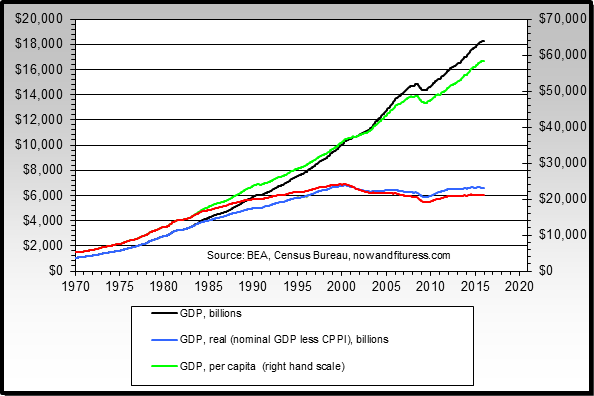 |
October 19, 2007 (Jeannine Aversa - AP Economics Writer)
World's Top Finance Officials Pledge to Limit Economic Fallout From Credit Crisis
Finance officials from the world's top economic powers pledged Friday to do all they can to limit damage to the global economy from a jarring credit crisis as Wall Street took another plunge.
"We remained committed to doing our part in sustaining strong global growth," the finance officials said in a joint statement. While saying the functioning of global financial markets was improving somewhat, they warned that "uneven conditions are likely to persist for some time and will require close monitoring."
"Powers" vow to fix the economy? My but that sounds ominous, in a black and white movie reel from the 1930s kind of way.
We were led to believe that the markets had all the power. Who are these powers who are going to fix the economy? Certainly not the same ones who broke it, we hope. Reminds us of this tidbit from our 1999 research for Ka-Poom Theory.
Apr. 25, 1932 (Time)
Plans for a third enormous national credit pump lay last week before the House Banking & Currency Committee. In January this committee helped design Reconstruction Finance Corp. to pump $2,000,000,000 of Federal funds through the nation's banks into Industry. In February, with the Glass-Steagall bill, it went to the rescue of the banks themselves by giving them a bigger & better pipe line into the Federal Reserve System. It was now proposed to pump Federal Reserve credit into the commodity markets— wheat, corn, beef, cotton, coffee, sugar. The bill was introduced by Representative Thomas Alan Goldsborough, Maryland Democrat. It required the Federal Reserve "to take all available steps to raise the present deflated wholesale level of commodity prices as speedily as possible to the level existing before the present deflation, and afterward to use all available means to maintain such wholesale commodity level of prices." Just how the Federal Reserve was to accomplish this large order nobody was sure.
George Leslie Harrison, governor of the Federal Reserve Bank of New York and Eugene Meyer, governor of the Federal Reserve Board, appeared before the Committee. Both opposed the Goldsborough bill. Their objections were similar: the Federal Reserve was now doing all it could to support the commodity markets; by itself it could not execute such a legislative mandate. Declared plump Governor Meyer: "I would not want to be peremptorily ordered to run 100 yards in ten seconds flat." The Federal Reserve, according to its chief, was now "holding the line" and "if you can hold the line, you can turn it eventually."
To specify what the Government had already done Mr. Meyer revealed that R. F. C. has helped out of trouble 1,319 banks of which 76% were in towns of 10,000 population or less.* Likewise since Feb. 1, $250,000,000 in currency had been returned to circulation by hoarders.†
But it remained for pipe-smoking Governor Harrison to lay the biggest piece of fiscal news down before the House Committee—namely, that the Federal Reserve was in the market for U. S. securities as never before. Its purchases were part of the Government's new determination to pump credit into the country—a process its friends call "reflation" instead of inflation—under the provisions of the Glass-Steagall bill. Not until its statement was issued later in the week was the full extent of the Federal Reserve's pumpings evident to the country.
The Glass-Steagall bill permits Federal Reserve banks to use Treasury obligations for part of their currency coverage, thereby releasing gold above the 40% minimum requirement. Open market operations in the U. S. securities have always been part of the Federal Reserve's function. Last autumn the Federal Reserve began a credit-pressure move of the kind now undertaken. England's gold crisis halted that move, but since the Glass-Steagall bill's enactment (Feb. 27), the Reserve has been quietly purchasing in the open market Federal securities at the rate of $25,000,000 per week. Last week it was buying them at the rate of $100,000,000 per week. Total purchases: $245,000,000. The U. S. security market fairly boomed, imparting strength down the line to the rest of the bond market.
The result of this new Government credit policy was to increase the funds at the disposal of Reserve member banks for commercial loans in the following manner: Bank A receives from a customer $500,000 in Government securities to sell. It turns them into the Federal Reserve bank which credits Bank A with $500,000. Bank A credits its customer with a $500,000 deposit on which it must pay interest. But it gets no interest on its own $500,000 Reserve deposit. Until it draws its Reserve deposit and puts it to profitable work at the service of commerce or industry, it is losing money.
Last week, as a result of open-market purchases by the Reserve banks, the system's member bank balance increased $69,000,000 to $2,011,000,000. In effect the Federal Reserve was stacking this pile of $69,000,000 (worth approximately $690,000,000 in new credit) in its front window and inviting member banks to come and get it for "reflationary"' purposes rather than to call loans to raise money.
*Last week the Treasury gave R. F. C. the last $150,000,000 of its $500,000,000 allotment. Hereafter to raise money R. F. C. will have to sell its own securities.
† Last week, after subscriptions of $30,000,000 the Treasury ceased selling "baby bonds" to absorb hoarded funds.
In the 1930s they had no idea how bad things were going to get if they waited too long to react to the post-credit bubble debt deflation. Plus the Fed, by even a casual reading of the minutes, was clearly composed of a pack of perfect dimwits.No such errors this time, but new ones. The key lesson the Fed learned: don't wait until the money supply has imploded and the banking system is crippled before acting. But no two circumstances are alike, and in the fullness of time the current FOMC will likely be seen as just as dimwitted but in a way unique to our times, such is the folly of trying to be a "power" over the markets.
Another lesson learned: a sure fire way to keep us all from "hoarding funds" is to take away the funds–in those days gold–as FDR did in 1933 by executive order, and raise the price by 30%. Presto, 30% monetary inflation. Oops, I mean "reflation," a more polite word invented at the time, and the one we chose to use in our Ka-Poom Theory of post-bubble disinflation/reflation cycles. Today, without gold backing, the Fed is free to simply print more fiat money to create inflation, I mean, reflation. The resulting mass behavior modification is to cause us all at once to think of hoarding old newspapers before government money. Better spend it while we can. So while the jobless claims numbers surprise four out of five economists on the upside by a factor of four, and living paycheck to paycheck is getting nearly impossible, the malls are jammed with shoppers eager to spend their paychecks before they're sent to reflation heaven by the latest round of bonar depreciation.
Our crusty old 2001 recession forecast is looking more every day like it should have been made for the approaching recession. In it we said:
"The fiscal 'surplus' of the past few years will turn out to be due primarily to capital gains tax receipts. As tax payers take capital gains losses against gains in 2001, tax receipts will fall by a greater extent than expected. Tax cuts, blessed by Greenspan last week and enacted to help the economy will create an enormous fiscal deficit for 2001."
Our 2001 recession forecast was about half right. The good news: the important half was correct: "The first stage of the depression is deflationary, the second inflationary."Those of us who invested in gold and other inflation hedges in 2001 did better than those who listened to the deflationists, legion at the time, and made deflation bets. That holds true today.
Next week, we review our now year old forecast of a post housing bubble recession starting in Q4 2007. We've learned a thing or two since 2000 and expect this forecast to be better than half right. Evidence is that this will be, without a doubt, the most peculiar recession ever, with some sectors of the economy booming while others are crashing, some geographic areas of the US contracting while others are still growing. On a whole, we figure the Alternative Energy and Infrastructure bubbles need to get cranked up and boosting demand in 18 to 24 months to keep the US from running into Japan 1990s style debt deflation cycle.
See also:
Bubbles in Everything... Sort of (subscription) Janszen - 10/19/07
Why oil and gold price increases are not bubbles but rather reflect monetary inflation.
The End of the Debt and Delusion (subscription) Janszen - 10/17/07
This is one of those pieces that EJ occasionally writes to help align readers' thinking more in line with long term historical processes versus consumed by the short term market news discussion in the mainstream business press that is designed to keep investors trading and generating fees for brokers and readership for their financial market publications, web sites, and blogs.
iTulip Select: The Investment Thesis for the Next Cycle™
__________________________________________________
For a book that explains iTulip concepts in simple terms see americasbubbleeconomy
For the safest, lowest cost way to buy and trade gold, see The Bullionvault
To receive the iTulip Newsletter or iTulip Alerts, Join our FREE Email Mailing List
Copyright © iTulip, Inc. 1998 - 2007 All Rights Reserved
All information provided "as is" for informational purposes only, not intended for trading purposes or advice. Nothing appearing on this website should be considered a recommendation to buy or to sell any security or related financial instrument. iTulip, Inc. is not liable for any informational errors, incompleteness, or delays, or for any actions taken in reliance on information contained herein. Full Disclaimer




Comment